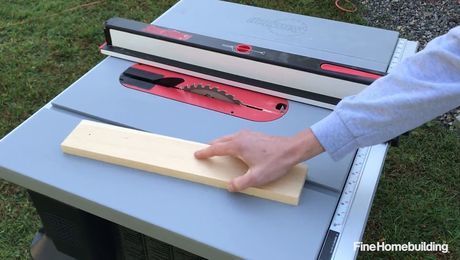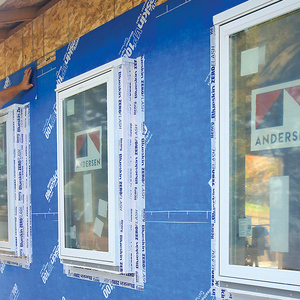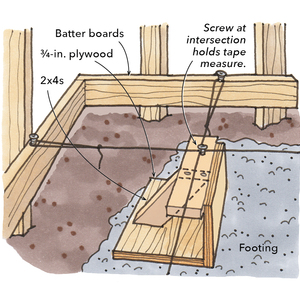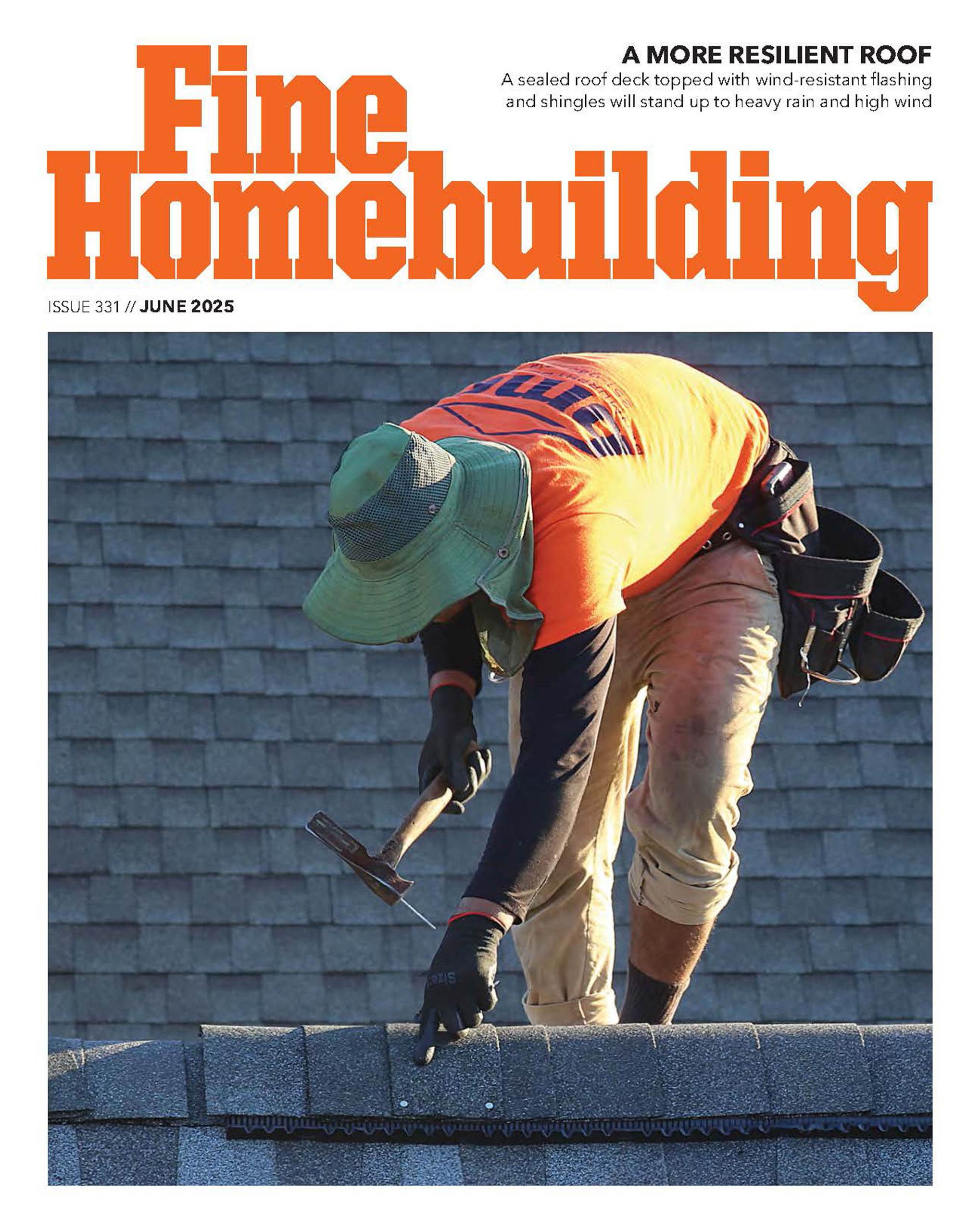I’m planning a garden studio for my wife. The finish I am planning is vertical oak boards with the joints covered by 2″ oak battens. I was wondering whether anyone has any experience of working with green oak as cladding. What are the pitfalls and how much shrinkage should I expect.
Discussion Forum
Discussion Forum
Up Next
Video Shorts
Featured Story

Look closely at these common locations for hazardous materials in older homes.
Featured Video
SawStop's Portable Tablesaw is Bigger and Better Than BeforeHighlights
"I have learned so much thanks to the searchable articles on the FHB website. I can confidently say that I expect to be a life-long subscriber." - M.K.
Fine Homebuilding Magazine
- Home Group
- Antique Trader
- Arts & Crafts Homes
- Bank Note Reporter
- Cabin Life
- Cuisine at Home
- Fine Gardening
- Fine Woodworking
- Green Building Advisor
- Garden Gate
- Horticulture
- Keep Craft Alive
- Log Home Living
- Military Trader/Vehicles
- Numismatic News
- Numismaster
- Old Cars Weekly
- Old House Journal
- Period Homes
- Popular Woodworking
- Script
- ShopNotes
- Sports Collectors Digest
- Threads
- Timber Home Living
- Traditional Building
- Woodsmith
- World Coin News
- Writer's Digest


















Replies
Greetings Farl,
This post, in response to your question, will bump the thread through the 'recent discussion' listing again which will increase it's viewing.
Perhaps it will catch someone's attention that can help you with advice.
Cheers
Peace full.
Red or White?
And what kind of finish, if any.
.
A-holes. Hey every group has to have one. And I have been elected to be the one. I should make that my tagline.
White French oak and, no I wasn't planning on putting a finish on
If french white oak is like american white oak, I suspect it will be beautiful and durable. Where are you located?
West Sussex. UK
What I'm really worried about is how much movement I can expect.
I imagine not a lot of movement. With board and batten siding, only one side of the board is secured solid. The other side is free to move under the batten. This style of siding was popular in the appalachian mountains, and stood the test of time well.
So, in short, the batten is secured to the same side the plank is secured, either through the plank into the studs, or just applied to it. There will be a gap between the planks for expansion, if you are using green lumber this will be small, as it will become a larger gap as the lumber dries out. Green lumber is much easier to work, but is heavy and may give problems after drying. Even so, I would rather work with green planks.
Thanks
I think that a clear picture is emerging. Green oak it is!
no, no, no!, 1 nail in the center of the board, and 1 nail in the center of the batten through the gap between adjacent boards. Make sure you caulk the gap between the boards at the bottom, make sure you have enough blocking between the studs to nail boards that will fall between them ..
bump
Edited 1/29/2008 10:05 am ET by rez
That this the way that I have heard of doign B and B. Nail in the center of the large boards. With each edge floating. And those edges restrained by the batten with an independent nail in to the structure.But with smaller boards I think that the other system will also work." Make sure you caulk the gap between the boards at the bottom, "However, that does not make any sense. Any water that works behind the batten (and it certain is not a water proof system will be trapped at the bottom.You want it free drainign..
.
A-holes. Hey every group has to have one. And I have been elected to be the one. I should make that my tagline.
the downfall of the board and batten I have done is that as the boards contract and the gap widens (most of the b&b I've done is with pine) there is a large gap between the boards under the batten to allow critters into the wall .. that is the purpose of the caulking .. I haven't had water drainage issues yet, but can see your point ..
Well, I wouldnot have entered the fray if rez had not summoned me. He knows how I hate to fight though...I do the one nail center like you but see no problem with one nail at edge like the other guys either.I do wonder about the caulk at bottom tho. What's the idea of that? I'd think it would be a water trap.
Welcome to the Taunton University of Knowledge FHB Campus at Breaktime. where ... Excellence is its own reward!
Does nailing in the center allow the board to shrink evenly?
Is that the benifit?
thanks
Yes, both edges shrink towards the center. If green i would hantg snug together.With nail at one edge, the board shrinks all from one side toward the other
Welcome to the Taunton University of Knowledge FHB Campus at Breaktime. where ... Excellence is its own reward!
My grandpa sided his gardening shed and garage with rough sawn oak boards and battens.After doing the shed the traditional way with nails he decided it was smarter to apply horizontal strapping around the garage and screw the battens in from the back.
Also,as you probably know,nail only one side of the board to prevent cracking due to shrinkage.The other side gets held in by the batten.This way there are no exposed fasteners to leave black streaks on the siding.
As far as finish,he used linseed oil with some melted parrafin mixed in for water proofing.I don't know the proportions,but he added some nu. 2 deisel in to cut the viscosity.I think you'd need to reapply every few years.Twenty years later it looks good but it did darken as it weathered(he's in WI).
Good luck
Thanks for the info. did he get much movement in the wood or not?
I don't know for sure,but it shouldn't be a problem as the width is covered by the battens.And shrinking lengthwise should be negligable.
Farl,
If no one has told you yet, you should be aware that white oak is an extremely durable wood but will darken dramatically with age. It's durability is caused by the excess tanins in white oak which protect it from decay. Those tannins are both a blessing and a curse.. blessing because of the durability of the wood. Curse because of regular nails are made of steel and the tannins in steel will attack the steeel and cause rust.. given enough time the rust will decay the wood so the boards will fall off.. Not right away but over time.. The solution is to nail or screw using stainless steel nails or screws..
I've seen galvanized nails used and if the galvinzation is real good and nothing gets knocked off installing them you should be fine. However if the galvinization gets knocked off and exposes the steel it will rust and rot.
The good news is that if you put things up while the wood is green it's relatively easy to nail.. not as easy as pine but massively easier than it will be if it dries. Allow a little more shrinkage for white oak than you'd allow for pine. It shrinks more.. the exact amount it will shrink depends on how wide the board, is how green it is when it goes up, the time of year it was sawn down, where the cut is made, (slabs from the center will be whats called 1/4 sawn and shrink a lot less than cuts near the edge which are called rift sawn and will shrink more, and the time of year it goes up..
I would paint the back side prior to installing.. you'll want to seal the wood eventually but you'll need to let the water that's currantly in the board (what is called bound water) release.. that takes approaximately an inch per year.
The reason you'll want to wait to paint the face but you can go ahead and paint the backside is because you'll want to seal up a dry board.. if the back side isn't painted or at least primed it will always be absorbing moisture on the back side and then vapor pressure will want to force moisture out the front of the boards.. That will cause the boards to blister ruining your nice paint job.
Oak boards will turn a nasty ugly black for a long time before eventually turning a wonderful grey. That's the period when most people give up and paint them which if you haven't primed or painted the backside will cause problems..
Since it's the backside the color doesn't matter so you can use whatever color you can find cheap..
With a 6" board, you should expect about 1/2" shrinkage when it dries. If French White Oak is anything like American White Oak it will be real durable (the heart wood is rot resistant, but the sap wood will rot). It will be much easier if you leave it rough cut.